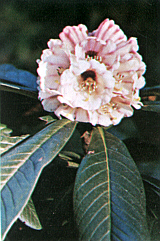QBARS - v24n4 Rhododendron basilicum R 167
R. basilicum R. 167
Cecil C. Smith, Aurora, Ore.

|
|
R basilicum
R 167
In Cecil Smith garden Photo by Cecil Smith |
The leaf petioles of this plant are short, broad, and winged as described under R. basilicum in the R H S species book. The leaf indumentum appears to have two distinct layers, indicating that this species should be associated with members of the Falconeri Series. However, the writer could not find cup shaped hairs in the outer layer as shown opposite page 239 in the species book. Small clumps of longer hairs can be seen in the indumentum, making it markedly different from the typical indumentum of the Series. R. basilicum is described in the Species of Rhododendron as having uniformly clothed, somewhat spongy indumentum.
As illustrated, the flower is as fine as any in the Series, and the new growth rank with the best.
Our plant is about seven feet high in twenty-one years, has bloomed twice, and appears to be budding for 1971 bloom. In our garden it seems to be as hardy as any in the Series.
Some years ago I saw a plant like this one in the Rudolph Henny garden, perhaps from the old Barto collection. More recently, several others have been reported in the Northwest. Of eight or ten gardens visited in the British Isles, we saw several of these plants at Edinburgh, and twenty or more in the Stevenson collection at the Valley Gardens at Windsor Great Park. Among the latter, the leaf petioles on some plants were not winged, but they all had the distinctive indumentum.
So far our plant has not produced pollen, but has set seed from other pollen. This plant is as good and is as reliable as any species that we can grow in our garden.
